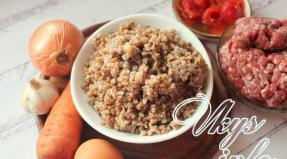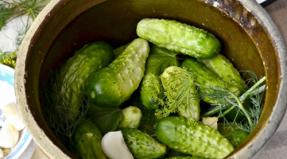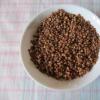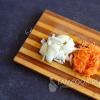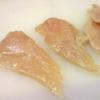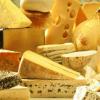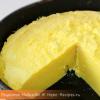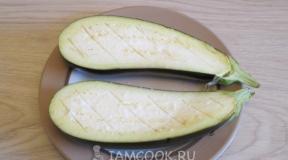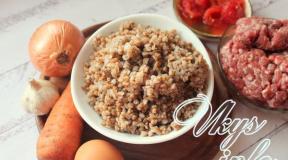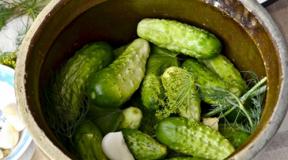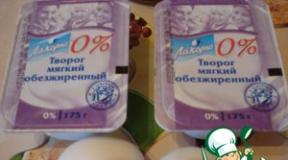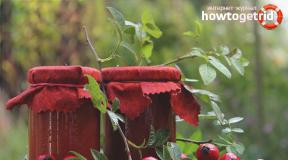Polenta: what it is, how to properly prepare a traditional dish of Italian cuisine. Step-by-step recipe for making classic polenta Classic polenta recipe made from corn flour
For the recipe with photos, see below.
Using corn flour, you can prepare a very tasty and satisfying dish called polenta. This is both porridge and pie in one. It is very tasty to serve polenta with sour cream, cheese, vegetable or meat sauce. The dish is very similar to mamaliga, but is most often made from corn grits. Due to this, its consistency is more grainy and loose.
Polenta is usually prepared from fine corn flour, thereby giving the finished porridge a dense and uniform consistency. When cooled, polenta thickens greatly, turning into something like a pie. Polenta is very common in Italy, where it was originally considered a porridge for the poor.
Ready-made frozen polenta can be cut into pieces and fried or baked with cheese and it is very tasty. Nutritionists recommend eating dishes made from corn grits and flour, because... They do not contain gluten, which means they are hypoallergenic. The high nutritional value of corn makes polenta a very healthy food.
To prepare polenta, you will need thick-walled, non-stick cookware. I use a cast iron cauldron for these purposes. Buy a package of cornmeal or polenta from the store.
The proportion is as follows: take 3 parts water for 1 part flour. Cook the porridge over low heat, stirring constantly with a wooden spatula. During the cooking process, I beat the porridge with an immersion blender to break the remaining lumps into a homogeneous mass.
Composition by product:
- 1 cup corn flour;
- 3 glasses of water;
- 1 tsp heaped salt;
- 1-2 tbsp. butter.
This polenta recipe can easily be made vegan by replacing the butter with olive oil.
How to cook polenta (step by step instructions)
Pour water into a saucepan or cast iron, add salt, and place on medium heat. Add the flour in a thin stream and begin to stir gently using a wooden spoon or spatula. Our goal is to stir all the lumps and achieve complete dissolution of the flour in the water. You can also use an immersion blender.
As soon as the water and flour boil, immediately reduce the heat to low and cook for 30-40 minutes, stirring. 15 minutes before the end of cooking, add butter or olive oil. By the end of cooking, the polenta should thicken considerably.

Transfer the finished polenta to a bowl or mold and leave to cool at room temperature. Once the dish has completely cooled, you can put it in the refrigerator and store it for 2-3 days under cling film or a lid.

When serving, heat a piece of polenta in the microwave, add sour cream, sauces or vegetables to taste. Bon appetit!
Everyone is interested in your opinion!
Don't leave in English!
There are comment forms just below.
How to properly prepare polenta from corn grits. A simple and delicious Italian dish. Polenta - detailed recipe with photos.
Cooking time- 1-1.5 hours.
Calorie content per 100 g- 90 kcal.
Polenta, a dish made from crushed corn kernels, first appeared in Italy back in the 16th century. After this golden cereal was brought from America to Europe by Columbus. Initially, this dish was prepared only by the poor. However, over time, it became widespread and won the love of Italian gourmets, turning from ordinary peasant food into a gourmet dish. Polenta is a universal food. The thing is that Italians use it not only as a side dish for meat and fish dishes, but also as a dessert, snack, and even instead of bread. It all depends on the recipe. And there are incredibly many of them.. In addition, it can be supplemented with vegetables, cheese, mushrooms, meat, or you can get a completely independent and very satisfying dish. For children, it is best to offer polenta with sweet fruit. In general, any gourmet will find a recipe to suit his taste. If you master the classic recipe for making polenta, then all its other variations will not seem difficult to you.
How to make polenta from corn grits
 To do this you will need to take:
To do this you will need to take:
- 1 cup polenta (very fine corn grits).
- 3 glasses of water.
- Salt to taste.
- Butter.
 To prepare this dish, very fine corn grits are used - almost flour. It is called “polenta”. To be more precise, it’s not even cereal, but coarsely ground corn flour, even made from it. By the way, the taste of the dish greatly depends on its quality. Cheap, low-grade flour will never make real polenta - smooth and velvety, with a delicate, creamy taste (website). But that's not all. Before you make polenta from corn grits, you will need to find a deep copper pot or pan with thick walls. In the old days, every Italian family had a special cauldron for these purposes, which hung over the hearth and a long wooden spoon for it. It was in it that Italian housewives prepared their traditional dish. But, given that it is quite problematic to get such a boiler these days, you can also use a regular Teflon heat-resistant saucepan. So, you will need to measure out exactly 3 cups of water. That is, the ratio of water to cereal should be exactly 3 to 1. No more, no less. When the water boils, salt it to taste, reduce the heat to low so that the water barely gurgles and add flour in a very thin stream, stirring continuously.
To prepare this dish, very fine corn grits are used - almost flour. It is called “polenta”. To be more precise, it’s not even cereal, but coarsely ground corn flour, even made from it. By the way, the taste of the dish greatly depends on its quality. Cheap, low-grade flour will never make real polenta - smooth and velvety, with a delicate, creamy taste (website). But that's not all. Before you make polenta from corn grits, you will need to find a deep copper pot or pan with thick walls. In the old days, every Italian family had a special cauldron for these purposes, which hung over the hearth and a long wooden spoon for it. It was in it that Italian housewives prepared their traditional dish. But, given that it is quite problematic to get such a boiler these days, you can also use a regular Teflon heat-resistant saucepan. So, you will need to measure out exactly 3 cups of water. That is, the ratio of water to cereal should be exactly 3 to 1. No more, no less. When the water boils, salt it to taste, reduce the heat to low so that the water barely gurgles and add flour in a very thin stream, stirring continuously.
 Now be patient because for the next 30-40 minutes your task will be to continuously stir the corn porridge. Patiently, carefully and without rushing anywhere. When the porridge begins to slightly lag behind the walls of the pan, and this will happen no earlier than half an hour later, you can turn off the heat.
Now be patient because for the next 30-40 minutes your task will be to continuously stir the corn porridge. Patiently, carefully and without rushing anywhere. When the porridge begins to slightly lag behind the walls of the pan, and this will happen no earlier than half an hour later, you can turn off the heat.
 Spoon the finished porridge onto a shallow baking sheet or other suitable container about a centimeter thick.
Spoon the finished porridge onto a shallow baking sheet or other suitable container about a centimeter thick.
 Flatten it with a spoon. Place the parchment on top and carefully level the entire mass with your hands again. Let it cool for about half an hour. Then remove the parchment.
Flatten it with a spoon. Place the parchment on top and carefully level the entire mass with your hands again. Let it cool for about half an hour. Then remove the parchment.
 Cut the frozen mass into pieces. You can also squeeze out circles with a glass - whatever you like.
Cut the frozen mass into pieces. You can also squeeze out circles with a glass - whatever you like.
Among the many Italian treasures that have become public property are culinary ones. Risotto, pasta, pizza, polenta - the most resounding “roll call” of Italian cuisine. In this list of celebrities, polenta has a special place. Having transformed from a poor man's porridge into a gourmet dish, it is priced at a shocking amount in some fine dining restaurants, even though the ingredients are the same as in the old village recipe. However, at the same time it is also the most democratic dish that can be found in any Italian trattoria*.
*a type of restaurant where there is no menu, but you are offered what is prepared.

Polenta: a short culinary dossier
Polenta is a dish made from corn flour, a type of thick porridge, a side dish or an independent dish if served with additives in the form of meat, anchovies, etc. It is most common in the northern regions of Italy. Analogues of polenta: hominy (Romania), gomi (Georgia), kachamak (Serbia). There is very thick polenta that can be cut with a knife, and there is soft and sweet polenta.Polenta has been known since at least the 16th century. To be fair, it should be said that long before Columbus brought corn to Italy, a similar porridge was cooked based on chopped chestnuts, peas, buckwheat, millet, and all this was called polenta. But after the expansion of corn cobs into the northern provinces of Italy, the history of polenta began a new countdown.
Corn polenta is porridge, bread, and pasta, in general, what the peasants of Lombardy, Piedmont and other northern regions began and ended their day with. Arrogant southerners nicknamed them polentoni (polenta eaters), receiving in response from their northern cousins an equally caustic one - maccheroni (pasta).
Each region has added its own twist to the polenta recipe, mostly out of a desire to make this simple dish even more delicious. Even if you don’t have the temperament of an Italian chef, you can experiment in your own kitchen and learn everything, as they say, by experience.

How to cook corn polenta: important details
The quality of your polenta depends on the quality of your flour. This dish should be smooth and creamy as cooking will completely dissolve any starch particles. This effect cannot be achieved with cheap low-grade flour; larger particles do not completely dissolve, leaving consumers with an unpleasant “sandy feeling in the mouth.”But that's not all. Experts advise: to make polenta soft, use 3 parts water and 1 part corn flour, plus 40-50 minutes of constant stirring over low heat. All other cooking methods are considered frivolous deviations from firmly established rules.
“Historical” technology involves the use of copper utensils - a cauldron in which the porridge is cooked, and a frying pan in which the finished porridge is fried, however, the latter is not necessary. Once upon a time, this process was not complete without a special polenta pot, Paiolo, hanging over the hearth and a long wooden spoon known as a Tarello.
In a modern kitchen, all you need is a good, heavy, heavy-bottomed saucepan and some cornmeal or, if you're lucky, a package of instant polenta. Although the cooking work is not as painstaking as it used to be, corn polenta still requires attention and occasional stirring.
Basic polenta recipe
- 1.5 glasses of water
- half cup yellow cornmeal
- salt to taste

ON A NOTE
If you don't have copper cookware, which is likely the case, use a thick-walled cast iron pan.
If corn flour is unavailable, you can replace it with corn grits. It's worse, but acceptable. Stirring is not canceled in this case either, but readiness occurs earlier - usually after 20-25 minutes. If you are using a package of polenta, cook according to the instructions.
Cooking and serving options
The key to polenta's popularity is its versatility. Cornmeal polenta can transform like Cinderella: it looks like a village simpleton - it’s just corn porridge! - it appears in the form of elegantly tailored quenelles from the chef of Grande cuisine.
In Italy, soft, warm polenta often replaces bread during meals, or is served instead of pasta, with cheese and truffle oil.
Polenta can also be served as a contorno (side dish) with original meat dishes, such as Osso Buco - meat shank stewed in wine, as well as lamb or rabbit meat. In Venice, corn polenta is a mandatory accompaniment to all fish dishes.
Due to the homogeneous structure of the finished polenta, it can be easily divided into pieces in the form of briquettes. They are heated in the oven or microwave, and a piece of feta is placed on top or cream cheese is spread, finishing the structure with pickled sweet peppers for piquancy. Want something more original? Place thin slices of lard on top of the polenta.
Another option for the oven: grate Parmigiano Reggiano and layer it with several improvised “cakes” of cooled polenta, folding them into a cake, then quickly bake - what’s not a snack Napoleon?
Polenta does great on the grill; The pieces of polenta browned in this way are placed on a slice of fresh bruschetta, similar to the traditional filling of mushrooms and tomatoes.
You can do even easier with leftover polenta. Without additional hassle, fry in a frying pan in butter, sprinkling with any hard cheese at the end.
Sweet polenta is eaten for breakfast, dipping small pieces into coffee with milk or cappuccino.


Looking for a classic polenta recipe? Well, I think to myself: if you came here, it means you are interested, and specifically in the classics, and not in what is written on the packaging. So, my dears, I have to disappoint you. Right from the very beginning. Look at this photo. Do you have such a boiler? No? If not, then you won’t get classic polenta, no matter what recipe you use to cook it. Because classic polenta is made in a thick-walled copper kettle over a wood fire. That's it! (By the way, "basta" is Italian.)
On a wood fire - this does not mean "on a fire." In Italy, until the end of the twentieth century, wood-burning stoves were very actively used in villages. And not only in Italy, by the way. If, say, you have a wood-burning stove at your dacha, then you have a chance to cook classic polenta. The only catch is the thick-walled copper boiler. Both wall thickness and material are very important. Copper is the most heat-conducting material of all used for cookware. It heats up very quickly and cools just as quickly when you remove the pan from the heat. Well, the thickness of the boiler allows it to be used in extreme heat, at those temperatures at which modern thin alloyed copper cookware simply deforms and changes color. In short, a pure copper old thick-walled boiler is a THING!!! But they are no longer produced. Ours is hereditary. But I don’t have a wood-burning stove, so even I can’t show you the recipe for classic polenta, even if I have the right boiler. I haven’t scared you off yet, will you continue reading?
Polenta is an old recipe, but not exactly from hoary antiquity. Corn came to Europe after the discovery of America, and in warm countries it seriously displaced other, more demanding and less productive cereal crops. In Italy, accordingly, polenta replaced pulse: a porridge made from ground spelled, millet, barley and spelt, known since the times of Ancient Rome. In short, the cereal has changed, but the recipe remains the same. So the technology for making polenta is damn old, and in our refined 21st century conditions it is very difficult to make it in its classic form.
I also tried classic polenta - exactly once in my life, my father-in-law prepared it when my parents came to meet me. The father-in-law's name was Giuseppe Manyago, he was from South Tyrol, whose inhabitants are called by Italians from the plains: “polenta eaters.” In short, I know the recipe, I can tell it, but I can’t cook it, because it’s simply impossible to install a domed copper boiler on a ceramic electric stove! I cook polenta in a cast iron flat-bottomed cauldron adapted for electric stoves. Will it suit you?
The main secret of classic polenta, which distinguishes it from the product that has replaced it now, is the use of two types of cereal, with different grinding calibers. In Italy you should take the coarsest and medium grind, but apart from the mills there, I have not seen this anywhere else, so in Germany I make it from corn grits and corn flour. Using two gauges gives a completely different consistency to the dish than using plain flour. But cooking requires a little more complex calculations than using one type of flour.
Ingredients for polenta are counted not in grams and milliliters, but in volumes. I converted it to grams for this recipe, but this is not the traditional approach. It is necessary to explain how this was done normally. You can’t imagine an Italian guy at a wood stove, measuring flour and water using scales and a measuring cup?
Our Giuseppe used the following ratio of grains for classic polenta: for 1 measure of coarse grinding - 2 measures of fine grinding. And water - 4 times more than corn grits in total. That is, 12 cups of water, 2 cups of fine cornmeal and 1 cup of coarse cornmeal. Cup, bowl, mug - it doesn’t matter anymore, you know? Historically, there was a large cauldron, and there was some kind of small container that was used to measure out water and cereals.

The water is brought to a boil and salted.

First, pour a bowl of large-caliber cereal into boiling salted water. Cook for about 5 minutes.

And after that, pour in 2 cups of corn flour in a thin stream with very thorough stirring. When they get into the water, the polenta starts spitting wildly, and you can get seriously burned. Much worse than just boiling water, because it is a sticky substance. Therefore, it makes sense to close the pot with polenta for a minute or two.

When you hear that the spitting has stopped, the lid can be removed. Then there are two cooking strategies: over low heat with almost no stirring (you get a homogeneous polenta) and over high heat with stirring (you get a dense polenta with a coarser and more heterogeneous structure). The first is easier to prepare and more beautiful, the second is more labor-intensive, but, according to our family, it tastes better.
Today is the birthday of the senior representative of our branch of the Manyago family, and the festive dinner was held at our place, so I prepared exactly their favorite option: labor-intensive and scary-looking. In short, what you will see from me is not a cooking defect, but a special honor for the birthday person. Nobody forbids you to leave the lid closed, reduce the heat to low and simmer the polenta for about half an hour.
I have to stir the polenta from the edge to the center and in a circle for 20 minutes over high heat. Those. it turns out that I am, in fact, whipping it. The parallel stripes on the walls are traces of a spatula. From top to bottom and to the center, the next movement is a little to the right, and so on, all the time in a circle. The high heat allows layers of thicker "skin" to form, which I continually stir into the liquid inner layers. Stirring stops when the polenta is actually pushed away from the wall of the boiler in this way. It should form into a single dense lump. The fact that it is heterogeneous is considered a special chic in our country. I’ll cook homogeneous liquid polenta in a saucepan.

After thickening, the surface of the polenta is compacted so that it becomes more or less even, and the polenta is kept on medium heat for another 5 minutes.

After removing from the stove, allow the polenta to cool for 5-10 minutes. It makes sense to pierce its edges with a spatula to the very bottom so that they can be easily separated from the walls. Next, a round serving board is pressed onto the polenta. Under no circumstances should you use a plate! If you want classics, then you need an absolutely flat wooden surface; such plates simply do not exist. I'll show you why a little further.

The pot of polenta is turned over and the polenta is placed on a wooden board. I can clearly see here that the crust has separated from the bottom of the cauldron. So, you will have to tear it off and throw it away, because the pot is cast iron and there is a black burn on the crust, and the crust itself is very hard and slightly bitter. But you can even eat the crust from the copper cauldron, it’s different. But it is not served with the polenta that is on the board; it is torn off and eaten for breakfast with milk. Well, at least our Giuseppe did.
Should it be cooked to a crisp? Classic polenta - yes, definitely. This gives it a special aroma - along with the smell of smoke from a wood stove.

Now look carefully. This is a serving of classic polenta, but it’s straight up like a polenta - it doesn’t get any better than a polenta: on a wooden board and with a string. The string should either be tied to two sticks, or have loops at the ends that you can stick your fingers through. It is also advisable to use a flat, wide spoon to transfer layers of polenta onto the eaters’ plates.

The fact is that classic polenta is cut not with a knife, but with a thread, and it is cut from the bottom up, not from the top down. The thread is brought under the polenta from below to the thickness of the piece, stretched and pulled upward at both ends. This is why you need a board and not a plate: plates always have sides, which get in the way with the classic cutting method.
In general, sorry for such a recipe with the volume of War and Peace, but classic polenta with all the bells and whistles is a dish that requires a lot of explanation. Because of the bells and whistles and because all the utensils for preparing it are simply not used in modern kitchens. For example, I make this polenta only for family holidays. It's a bit of a show. But these are also traditions. Our son is just as interested in cutting polenta with a string as it was fun for his father and uncles to do as a child.
Maybe you could still prepare the polenta according to the recipe on your package? It's probably simpler.

